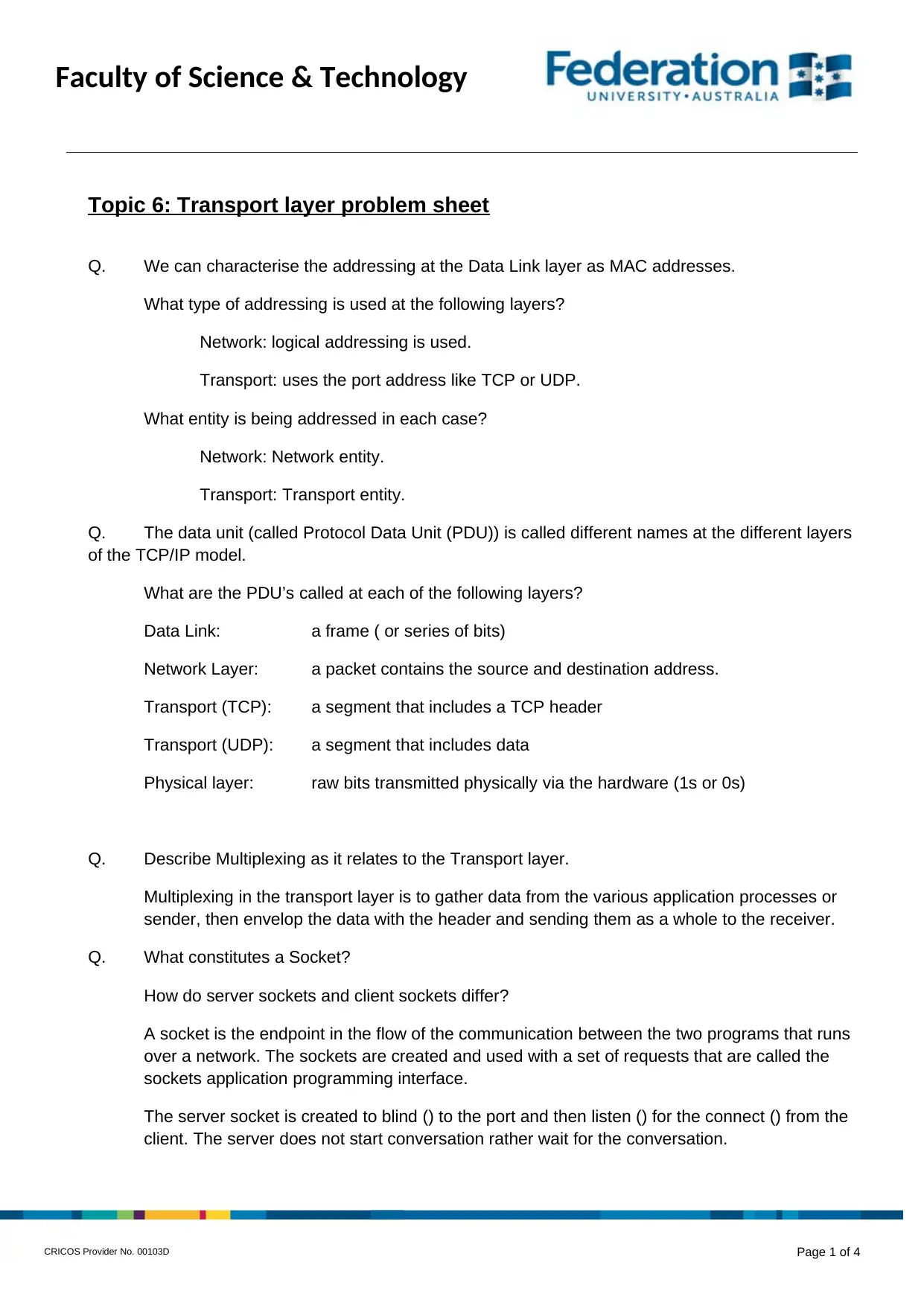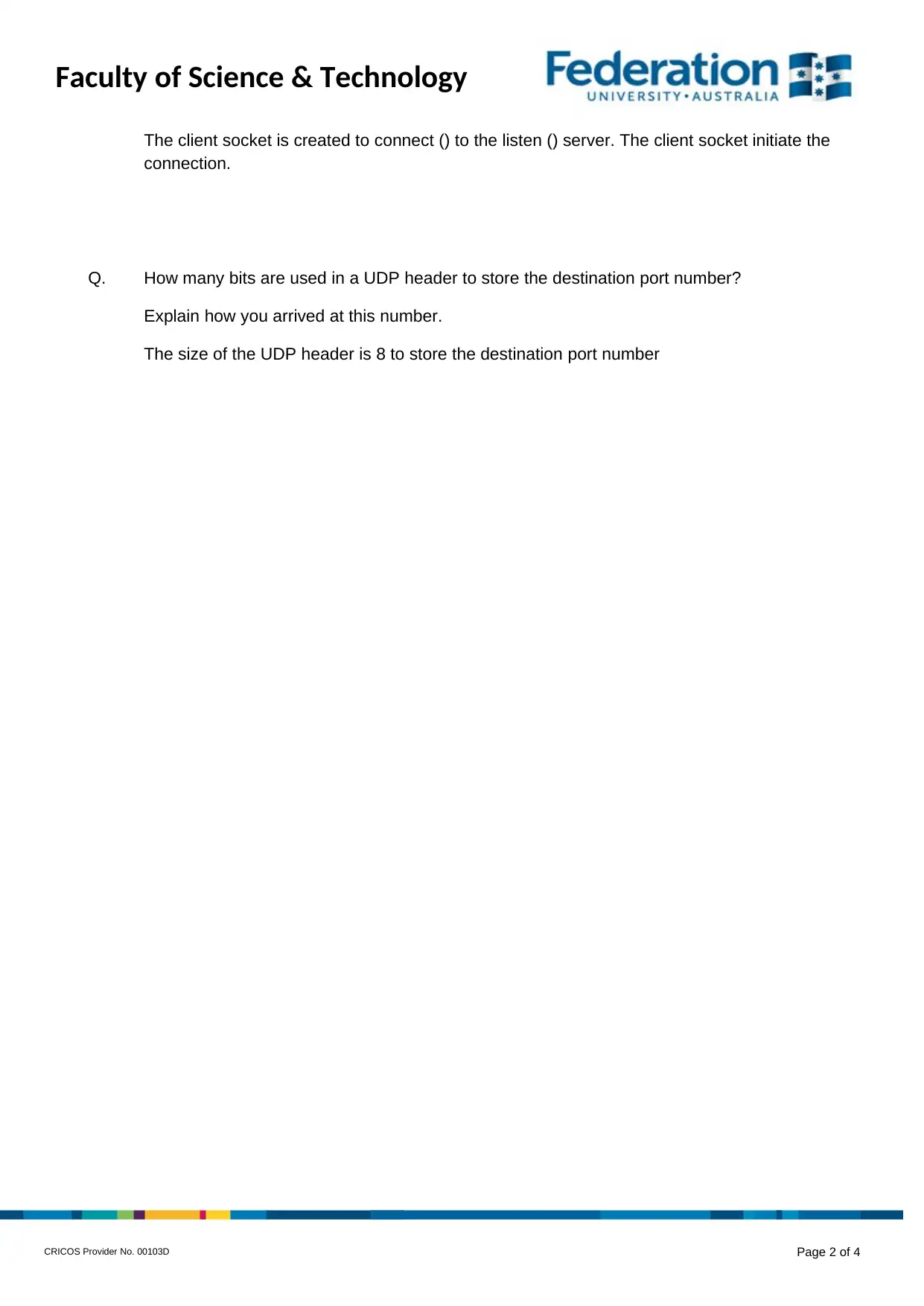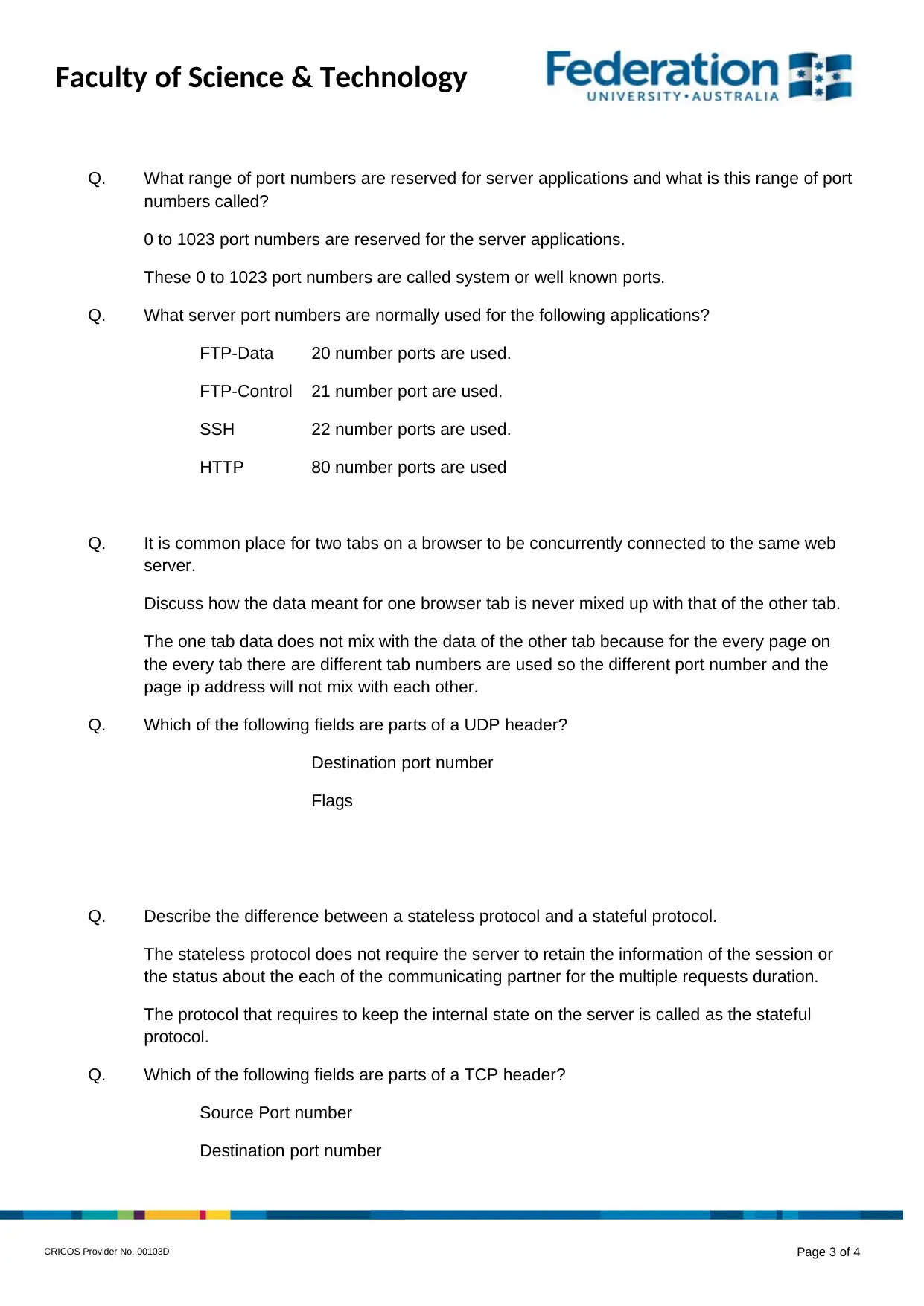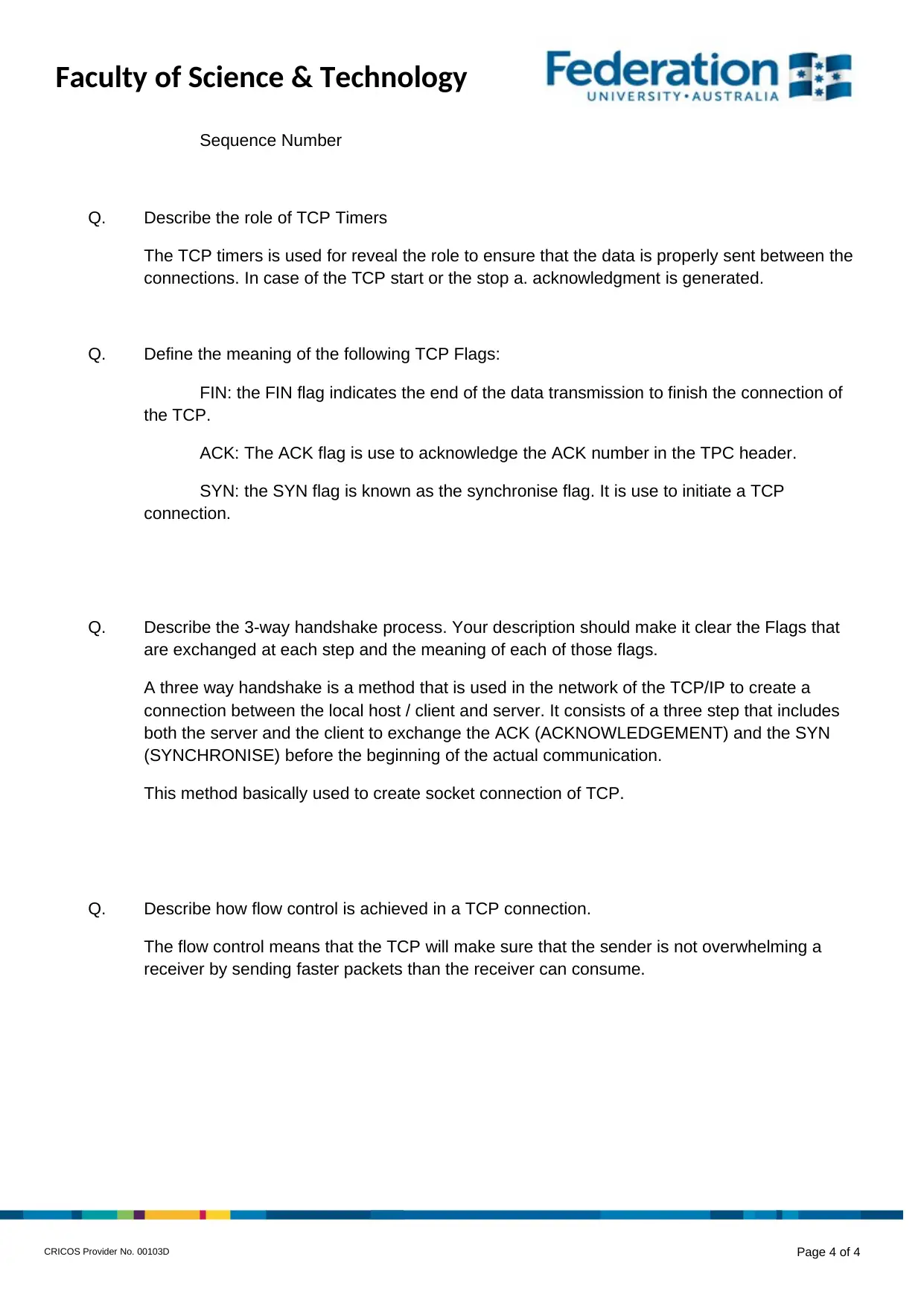ITECH1102 Networking and Security: Transport Layer Problem Solution
VerifiedAdded on 2023/06/11
|4
|972
|168
Homework Assignment
AI Summary
This document provides solutions to a problem sheet on the Transport Layer, covering key concepts in networking and security. The questions address addressing types at different layers (Network and Transport), the names of Protocol Data Units (PDUs) at various layers of the TCP/IP model, and multiplexing in the Transport Layer. It also explains what constitutes a socket, the differences between server and client sockets, and the structure and purpose of UDP and TCP headers, including port numbers and flags. Further topics include stateless vs. stateful protocols, TCP timers, the 3-way handshake process, and flow control in TCP connections. Desklib offers a range of study tools, including past papers and solved assignments, to support students in mastering these concepts.

Faculty of Science & Technology
Topic 6: Transport layer problem sheet
Q. We can characterise the addressing at the Data Link layer as MAC addresses.
What type of addressing is used at the following layers?
Network: logical addressing is used.
Transport: uses the port address like TCP or UDP.
What entity is being addressed in each case?
Network: Network entity.
Transport: Transport entity.
Q. The data unit (called Protocol Data Unit (PDU)) is called different names at the different layers
of the TCP/IP model.
What are the PDU’s called at each of the following layers?
Data Link: a frame ( or series of bits)
Network Layer: a packet contains the source and destination address.
Transport (TCP): a segment that includes a TCP header
Transport (UDP): a segment that includes data
Physical layer: raw bits transmitted physically via the hardware (1s or 0s)
Q. Describe Multiplexing as it relates to the Transport layer.
Multiplexing in the transport layer is to gather data from the various application processes or
sender, then envelop the data with the header and sending them as a whole to the receiver.
Q. What constitutes a Socket?
How do server sockets and client sockets differ?
A socket is the endpoint in the flow of the communication between the two programs that runs
over a network. The sockets are created and used with a set of requests that are called the
sockets application programming interface.
The server socket is created to blind () to the port and then listen () for the connect () from the
client. The server does not start conversation rather wait for the conversation.
CRICOS Provider No. 00103D Page 1 of 4
Topic 6: Transport layer problem sheet
Q. We can characterise the addressing at the Data Link layer as MAC addresses.
What type of addressing is used at the following layers?
Network: logical addressing is used.
Transport: uses the port address like TCP or UDP.
What entity is being addressed in each case?
Network: Network entity.
Transport: Transport entity.
Q. The data unit (called Protocol Data Unit (PDU)) is called different names at the different layers
of the TCP/IP model.
What are the PDU’s called at each of the following layers?
Data Link: a frame ( or series of bits)
Network Layer: a packet contains the source and destination address.
Transport (TCP): a segment that includes a TCP header
Transport (UDP): a segment that includes data
Physical layer: raw bits transmitted physically via the hardware (1s or 0s)
Q. Describe Multiplexing as it relates to the Transport layer.
Multiplexing in the transport layer is to gather data from the various application processes or
sender, then envelop the data with the header and sending them as a whole to the receiver.
Q. What constitutes a Socket?
How do server sockets and client sockets differ?
A socket is the endpoint in the flow of the communication between the two programs that runs
over a network. The sockets are created and used with a set of requests that are called the
sockets application programming interface.
The server socket is created to blind () to the port and then listen () for the connect () from the
client. The server does not start conversation rather wait for the conversation.
CRICOS Provider No. 00103D Page 1 of 4
Paraphrase This Document
Need a fresh take? Get an instant paraphrase of this document with our AI Paraphraser

Faculty of Science & Technology
The client socket is created to connect () to the listen () server. The client socket initiate the
connection.
Q. How many bits are used in a UDP header to store the destination port number?
Explain how you arrived at this number.
The size of the UDP header is 8 to store the destination port number
CRICOS Provider No. 00103D Page 2 of 4
The client socket is created to connect () to the listen () server. The client socket initiate the
connection.
Q. How many bits are used in a UDP header to store the destination port number?
Explain how you arrived at this number.
The size of the UDP header is 8 to store the destination port number
CRICOS Provider No. 00103D Page 2 of 4

Faculty of Science & Technology
Q. What range of port numbers are reserved for server applications and what is this range of port
numbers called?
0 to 1023 port numbers are reserved for the server applications.
These 0 to 1023 port numbers are called system or well known ports.
Q. What server port numbers are normally used for the following applications?
FTP-Data 20 number ports are used.
FTP-Control 21 number port are used.
SSH 22 number ports are used.
HTTP 80 number ports are used
Q. It is common place for two tabs on a browser to be concurrently connected to the same web
server.
Discuss how the data meant for one browser tab is never mixed up with that of the other tab.
The one tab data does not mix with the data of the other tab because for the every page on
the every tab there are different tab numbers are used so the different port number and the
page ip address will not mix with each other.
Q. Which of the following fields are parts of a UDP header?
Destination port number
Flags
Q. Describe the difference between a stateless protocol and a stateful protocol.
The stateless protocol does not require the server to retain the information of the session or
the status about the each of the communicating partner for the multiple requests duration.
The protocol that requires to keep the internal state on the server is called as the stateful
protocol.
Q. Which of the following fields are parts of a TCP header?
Source Port number
Destination port number
CRICOS Provider No. 00103D Page 3 of 4
Q. What range of port numbers are reserved for server applications and what is this range of port
numbers called?
0 to 1023 port numbers are reserved for the server applications.
These 0 to 1023 port numbers are called system or well known ports.
Q. What server port numbers are normally used for the following applications?
FTP-Data 20 number ports are used.
FTP-Control 21 number port are used.
SSH 22 number ports are used.
HTTP 80 number ports are used
Q. It is common place for two tabs on a browser to be concurrently connected to the same web
server.
Discuss how the data meant for one browser tab is never mixed up with that of the other tab.
The one tab data does not mix with the data of the other tab because for the every page on
the every tab there are different tab numbers are used so the different port number and the
page ip address will not mix with each other.
Q. Which of the following fields are parts of a UDP header?
Destination port number
Flags
Q. Describe the difference between a stateless protocol and a stateful protocol.
The stateless protocol does not require the server to retain the information of the session or
the status about the each of the communicating partner for the multiple requests duration.
The protocol that requires to keep the internal state on the server is called as the stateful
protocol.
Q. Which of the following fields are parts of a TCP header?
Source Port number
Destination port number
CRICOS Provider No. 00103D Page 3 of 4
⊘ This is a preview!⊘
Do you want full access?
Subscribe today to unlock all pages.

Trusted by 1+ million students worldwide

Faculty of Science & Technology
Sequence Number
Q. Describe the role of TCP Timers
The TCP timers is used for reveal the role to ensure that the data is properly sent between the
connections. In case of the TCP start or the stop a. acknowledgment is generated.
Q. Define the meaning of the following TCP Flags:
FIN: the FIN flag indicates the end of the data transmission to finish the connection of
the TCP.
ACK: The ACK flag is use to acknowledge the ACK number in the TPC header.
SYN: the SYN flag is known as the synchronise flag. It is use to initiate a TCP
connection.
Q. Describe the 3-way handshake process. Your description should make it clear the Flags that
are exchanged at each step and the meaning of each of those flags.
A three way handshake is a method that is used in the network of the TCP/IP to create a
connection between the local host / client and server. It consists of a three step that includes
both the server and the client to exchange the ACK (ACKNOWLEDGEMENT) and the SYN
(SYNCHRONISE) before the beginning of the actual communication.
This method basically used to create socket connection of TCP.
Q. Describe how flow control is achieved in a TCP connection.
The flow control means that the TCP will make sure that the sender is not overwhelming a
receiver by sending faster packets than the receiver can consume.
CRICOS Provider No. 00103D Page 4 of 4
Sequence Number
Q. Describe the role of TCP Timers
The TCP timers is used for reveal the role to ensure that the data is properly sent between the
connections. In case of the TCP start or the stop a. acknowledgment is generated.
Q. Define the meaning of the following TCP Flags:
FIN: the FIN flag indicates the end of the data transmission to finish the connection of
the TCP.
ACK: The ACK flag is use to acknowledge the ACK number in the TPC header.
SYN: the SYN flag is known as the synchronise flag. It is use to initiate a TCP
connection.
Q. Describe the 3-way handshake process. Your description should make it clear the Flags that
are exchanged at each step and the meaning of each of those flags.
A three way handshake is a method that is used in the network of the TCP/IP to create a
connection between the local host / client and server. It consists of a three step that includes
both the server and the client to exchange the ACK (ACKNOWLEDGEMENT) and the SYN
(SYNCHRONISE) before the beginning of the actual communication.
This method basically used to create socket connection of TCP.
Q. Describe how flow control is achieved in a TCP connection.
The flow control means that the TCP will make sure that the sender is not overwhelming a
receiver by sending faster packets than the receiver can consume.
CRICOS Provider No. 00103D Page 4 of 4
1 out of 4
Related Documents
Your All-in-One AI-Powered Toolkit for Academic Success.
+13062052269
info@desklib.com
Available 24*7 on WhatsApp / Email
![[object Object]](/_next/static/media/star-bottom.7253800d.svg)
Unlock your academic potential
Copyright © 2020–2025 A2Z Services. All Rights Reserved. Developed and managed by ZUCOL.





